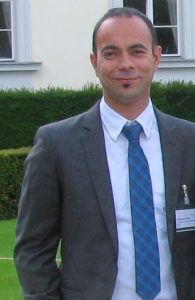Akashdeep Kamra, Universidad Autonoma de Madrid
The magnon-cooparon quasiparticle
Generating and moving unconventional spinal Cooper pairs using magnons
When: 12:00-13:00 CET, February 16th (Thursday), 2023
Where: Seminar Room, ICMM-CSIC, Campus de Cantoblanco, Madrid
A superconductor is formed when pairs of electrons undergo condensation into a macroscopically coherent state with a common order parameter. Its supporting dissipationless flow of charge currents underlies the central role that superconductors are playing in various emerging quantum technologies. The widely used conventional superconductors are constituted by spin-singlet Cooper pairs. These are formed by electrons bearing opposite spin, and therefore bear no net spin. For various phenomena, such as dissipationless magnetic memories and Majorana excitations, it is desirable to have equal-spin triplet Cooper pairs formed by electrons with the same spin. Engineering and controlling such exotic Cooper pairs has thus been a main goal and challenge for the scientific community [1].
In this talk, we will discuss some recent theoretical efforts in achieving the generation and control of such spin-triplet Cooper pairs using magnetic insulators and their spin excitations – magnons. We will show that if the superconductivity is mediated by antiferromagnetic magnons, instead of phonons, the resulting superconducting state is unconventional and can achieve a relatively high critical temperature [2,3]. This can be accomplished in bilayers comprising an antiferromagnetic insulator (AFI) interfaced to a normal metal. Furthermore, unconventional Néel spin-triplet Cooper pairs with pairing amplitude oscillating at atomic length scales have recently been predicted to emerge in AFI/superconductor bilayers [4]. Finally, we will discuss the emergence of a novel quasiparticle – magnon-cooparon – in a conventional superconductor interfaced with a ferromagnetic insulator [5]. The spatially inhomogeneous exchange field generated by a magnon in the ferromagnet induces spin-triplet Cooper pairs in the adjacent superconductor which act to screen the magnon spin. This quasiparticle, reminiscent of the polaron excitation, allows driving the spin-triplet Cooper pairs in a desired direction employing mature techniques from the field of magnonics. The magnon-cooparon also enables a powerful magnonic directional coupler, a key element in magnon-based logic and computing paradigms.
References:
[1] Matthias Eschrig. Spin-polarized supercurrents for spintronics: a review of current progress. Rep. Prog. Phys. 78, 104501 (2015).
[2] A. Kamra, A. Rezaei, and W. Belzig. Spin splitting induced in a superconductor by an
antiferromagnetic insulator. Phys. Rev. Lett. 121, 247702 (2018).
[3] E. Erlandsen, A. Kamra, A. Brataas, and A. Sudbø. Enhancement of superconductivity
mediated by antiferromagnetic squeezed magnons. Phys. Rev. B 100, 100503(R) (2019).
[4] G. A. Bobkov, I. V. Bobkova, A. M. Bobkov, and A. Kamra. Néel proximity effect at
antiferromagnet/superconductor interfaces. Phys. Rev. B 106, 144512 (2022). [5] I. V. Bobkova, A. M. Bobkov, A. Kamra, and W. Belzig. Magnon-cooparons in magnet-
superconductor hybrids. Communications Materials 3, 95 (2022).
